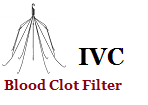 IVC Filters are not FDA approved. They were only cleared for use through the FDA’s 510(k) process. Were IVC blood clot filters formally approved by FDA through the agency’s regular device approval process, the people injured by them would have little to no legal recourse to pursue claims against IVC filter makers C.R. Bard, Cook Medical, Boston Scientific and others.
IVC Filters are not FDA approved. They were only cleared for use through the FDA’s 510(k) process. Were IVC blood clot filters formally approved by FDA through the agency’s regular device approval process, the people injured by them would have little to no legal recourse to pursue claims against IVC filter makers C.R. Bard, Cook Medical, Boston Scientific and others.
The 510(k) Approval Process
The popularity of 510(k) clearance among device makers stems from its relative lack of rigor – devices reach the market much more quickly and less expensively under this process than under other FDA avenues of review.
The traditional premarket approval process for a medical device typically involves some 1,200 review hours, as opposed to the 510(k) process, which is completed in an average of 20 hours.
The 510(k) process was not designed to evaluate the safety and effectiveness of a device. A finding of ‘substantial equivalence’ signifies only that the device is similar in certain respects to a previous predicate device. No determination about risks to safety or effectiveness comes as a result of clearance through the 510(k) process.
Cook Gunther Tulip Clearance Process
Tulip was designed and primarily intended to be a permanent filter. On Oct. 28, 1999, Cook submitted a 510(k) application to make Tulip a permanent and retrievable filter, but the FDA refused to approve it. FDA told Cook the device was not substantially equivalent and furthermore told Cook the retrievability function required clinical data. Cook then appealed the FDA’s decision, and the FDA rejected that appeal.
Cook on March 15, 2000 submitted a 510(k) for permanent placement only, and the FDA cleared (but did not approve) Tulip on Oct. 18, 2000 only as a permanent filter, after finding substantial equivalence to two predicate devices – the Greenfield filter and Vena Tech filter (both permanent devices).
Gunther Tulip 41 Patient Study
Cook began a 41-patient study in November 2000 to assess the retrievability of the Gunther Tulip, using a 14-day retrieval window. Cook retrieved 26 (63%) of the filters, finding one (1) had migrated to the heart and nine (21%) had tilted. Then in Sept. 2002 Cook decided before this study ended that it would not be conducting a pivotal study to expand upon the 41-patient pilot study. (This was a curious choice, given the tiny number in the patient study and the dearth of safety information for the Gunther Tulip).
Pilot Study
According to the FDA Guidance for Industry and FDA Staff, a Pilot Study is a preliminary clinical study to see, for example, if a pivotal study is practical or to refine the study protocol for the pivotal study.
The FDA cleared Tulip on Oct. 31, 2003 for optional retrieval based on the 41-person pilot study. The mean time of retrievability was 11 days on the Pilot Study.
Filter Dwell Times Matter
One might reasonably ask, ‘What about all the people who perhaps needed the filter removed after 11 days or 2 weeks time?’ Neither Cook nor the FDA seemed concerned with those people, nor the thousands who would be implanted with filters left in far longer than 11 days. There seems to be a decided lack of guidance from Cook, and little to no follow up from the FDA, regarding the safety of leaving in temporary filters for extended periods of time.
Gunther Tulip Filter Analysis
The Journal of Vascular and Interventional Radiology published an analysis of the Gunther Tulip Filter on Jan. 20, 2008. Results were as follows:
- Retrospective review of 175 patients with Gunther Tulip placement
- Review all medical records and cavagrams of all 175 patients.
- 159/175 patients had TILT (91%) upon 1st retrieval attempt.
- Tilt is a form of malpositon whereby the apex of the filter points in a direction other than the cylindrical axis of the local cava.
- Frequency of tilt 25% of patients > 14 degree Tilt (to wall of filter)
- No result in decreased clot-trapping abilities and increased complications, thrombosis and difficulty removing.
IVC Filter Removal Difficulties
A Journal of Medical Imaging and Radiation Oncology article published in 2008 analyzed the difficulty of removing Gunther Tulip filters. The paper examined 205/322 Gunther Tulip Filters with attempted removals. It also found that retrieval periods for the Gunther Tulip filter have continued to lengthen, despite the initial recommendations of removal within 14 days, which is now at the physician’s discretion. Perhaps most importantly, the authors wrote, “Our data suggest (that) the extended filter dwell times may compromise successful removal.”
The Gunther Tulip and other IVC filters clearly have some problems.
To be continued. . .
Related
- IVC Filter Lawsuit
- Cook IVC Filter Attorney
- Bard IVC Filter Lawsuit
- Cook Blood Clot Filter Lawsuits

by Matthews & Associates




